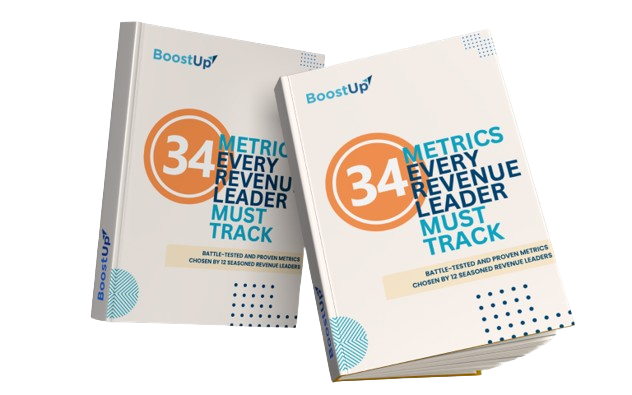JAMES MASON: Yeah, thanks, thanks, Matt, for that. So, for my 3 metrics that I wanted to share on the podcast is really around pipeline coverage, loss prevention, and discounting. And as I was thinking about the key areas that I look at as an operational manager in the business I'm working in right now,
the importance of "I'm making the number", is kind of where I focus my content. So obviously being in operations, we could measure everything under the sun right? There's thousands of things we could think about, and I tried to carry a theme of progression towards attainment in the metrics that I pulled together, which is why I chose these 3 in particular.
MATT DURAZZANI: One question I have with regards to one of the terms that you use in the previous slide, if you can go back to that for a second. For those operators that may have not heard the term "discounted" before, Do you mind kind of set the premise of what discounting is within the context of your presentation today?
JAMES MASON: Sure. So maybe I should have probably put on the "discounting behavior". So we're looking at the amount of discount that sales offer in order to win a deal. I'll touch on it in my section, but in some of my companies we worked through channel partners, and there was already a very strict amount that was offered off the back. And so the extras that sales give in order to win deals. That's what I'll be focusing on how to maximize that.
MATT DURAZZANI: excellent Thank you. Let's go ahead into your first metric.
JAMES MASON: So my first one and I think I'll probably put this as number one of of importance is the pipeline coverage. For me, I define the pipeline coverage as the amount of open opportunity that I have as a sales rep or as the sales manager of a team, versus my target that I'm trying to achieve. And really what this does is it gives me a first glimpse into "do I really have a capacity or a chance at the moment of hitting my target or attaining my quota the reason why I like this metric in particular is it drives action and conversation along the themes of what do I need to do in order to build more pipeline, What do I need to mature my pipeline? What else do I need to do that's going to make those opportunities more sure of winning. And so as an operations manager, the way that I put this together for my sales teams is, you know, I've mocked up this graph here, so the blue line is the pipeline. So this is every open opportunity that relates to the Reps that I'm measuring. So maybe these are only new business reps. Maybe these are renewal reps. Whatever team they are, it's the associated pipeline opportunities that they own, regardless of any other factor, just that they are in play. I've put here an arbitrary orange line to indicate the target of the 5 reps, so I'm just giving them a made up target of 2 million dollars here. And we can see uh, various blue lines are above that at different degrees. One of them is below.
So immediately those managers or those reps can be having the conversation of you've got a 2 times your target pipeline. So, for example, rep number one is 4 million, that's twice as much as this target. So he might be thinking, I'm in a good spot because I've got twice as much than I need. Rep 3 is having a great day, because he's got 3 times as much. But the thing that is lacking in the next days down that we go in this, is what we call weighted pipeline. And we call it weighted is because not every opportunity is created equal right. They're not all the same stage. They haven't all progressed at the same point. They don't all have the economic buyers engaged, or some have got channel partners, some don't. They all, have different characteristics.
And so what we need to do to get a more accurate picture of "can I hit my number?", is weight these opportunities on those characteristics. And it doesn't have to be on probability of closure, right. That's slightly different. What we're doing here is, we're giving them a an arbitrary value based on the progression. So more along the lines of the sales stage. That's what I'm measuring here, and we then do a little bit of math in the background, and we end up seeing that the red line which is now your weighted pipeline value is decreased. so rep number one, who was thinking, I've got twice as much pipeline as I need. Actually now, when you look at that has got a gap. because maybe their opportunities weren't as progressed as they should be. When you get to that point, it's a good metric to have. Now you have an idea of the maturity of a pipeline, you can go ahead and have those conversations of what do we do next? The next stage I take that to is using the the win rate. So I at the moment, I support a particular team within scandit, whose win rate is somewhere around the 45-50% mark. So what I do is I use that win rate against the weighted pipeline value, and that gives me a bit more of a narrow focused in on where they're going to finish. And then that puts me in a much better conversation point to be able to say this is what I expect to finish. This is my gap. How do I make it up?
MATT DURAZZANI: Okay, that makes sense. This is very smart to do. I really like it. I have a couple of questions for you on this one. You were saying earlier that one of the benefits of looking at the pipeline through this type of lens it empowers the team with having the right type of conversations. I would like to ask for maybe a couple of examples of first of all, are these type of conversations just happening on the operational side, or are they happening with leaders and reps? And you know, and what are some of those key actions that come out of it. Can you provide a like an example or 2 out of that?
JAMES MASON: Yeah, well of course. the way that I operate as a Sales operations person is to be as close to the sales leaders as possible. So when we talk about these conversations happening more often than not, I'm going to be out of the the audience that's happening. But this is primarily really a conversation to have between manager and rep. And then, maybe of the next stage up of, you know the VP and the sales director. An example might be if we're talking to rep number 3. In this example, he first of all started with a massive pipeline. Probably thinking he's got it made, doesn't have to do a lot of work. It is queued because he's going to smash it. When we come to him with this analysis we can see that he's only just about going to make his number, overshooting maybe 10%. We will then sit there with him and go through his most progressed deals.
We'll talk about risk factors. We'll talk about who's engaged on the customer side or the Channel side? What's their Purchase order process look like. Almost like a mini deal deep dive into how safe are those deals, really. And then, if we start to identify risk, then we turn the conversation to that red line and say right, there must be another one or 2 opportunities that we could push a little bit further along the progression, just to give us a buffer of safety.
And if I'm a manager who's got these 5 reps, I might also be thinking Rep Number 3 is my best chance at meeting my number as a team, given the position that rep Number 4 and rep number one are in with the orange lines, I might have to lean on 3 a little bit more to to push up my team's achievement from that perspective. So yeah, in that example, it's very much a front line manager conversation trying to understand the the maturity and the hygiene behind what's what's really in front of us in the data?
MATT DURAZZANI: That's excellent. Thank you for that. We're we're ready for metric number 2, if you want
JAMES MASON: So my number 2, I nickname this my "when loss" instead of my win-loss right. We we know about a win lost ratio, but I'm borrowing that name to be a when loss, and what I'm looking at here is the opportunities that are exiting my pipeline and getting closed lost, I'm looking at that as a volume of my overall pipeline at that stage. But also then I'm looking at that from the particular stage they exit.
So at the bottom here I've got my 5 sale stages. number one being the earliest number 5 being right before we go closed won. and what I'm trying to understand from this metric is, how good is my qualify-out activity, right? We we're so focused on qualifying opportunities in and justifying why they should exist that actually, sometimes I think we need to take the opposite view on our qualification and say if you only meet 60% of my criteria, I'm not going to waste my time on you. I need to put you somewhere else to be nurtured and progress somewhere else.
This helps us identify that we're also looking at our competitiveness right, where do we lose most? where we come up against most competition, whether that's in the face of a challenge, or an actual competitor, or a a pricing issue or or product issue. And then what we're trying to do is really identify a trend here. Is there a pattern to me as as a rep, or as the front line manager, Do I always lose at the same point in a sale cycle, or is there always a common reason why I'm losing their common competitor? Things like this.
And so when I look at the graph here, and I'm looking at the south stages across the bottom, the blue bars are indicating the number of opportunities have gone to closed lost from that stage and the the red line is identifying what percentage of my pipeline at that stage, those are responsible for. So stage number one, for example had 125 opportunities that was about 70-ish % of my pipeline at that point. Now Why we do this at the stages is really to do along the lines of the maturity and the progression that we talked about in the first metric in an ideal world. The blue bars form this type of pattern. You qualify out early, so that you don't waste resource and time on progressing deals that aren't going to go anywhere.
You come up against deal breakers very early on, and you can move on to the next one. So the Blue Bar is a good trend that we try and see. Obviously we'd like the numbers to be as low as possible, but that's sales. The red line would follow hopefully a very similar trend, or or be very flat towards the bottom. And so, in this example, what I've done is, I've crafted this stage number 3 showing that although I'm losing less into stage number 3, which is good, the amount, or the percentage rather of my pipeline that I have lost is significantly high.
So, as I'm looking at this from my perspective of a an operations leader or a sales leader, I can immediately say there's something about that stage or those deals in that stage that meant I lost more than I should have done so now this is where I'm going to focus my discussion with my rep. Maybe I'm going to loop in my Channel team as well to understand what did the Channel contribute or not in in these deals, and we start to focus into what happened with those.
MATT DURAZZANI: Yeah, I love this one. You know. It's interesting because oftentimes, and I think for a lot of CRO's or other sales leaders it's very, very common to just identify what wins, and one of the things that a lot of revenue operations leaders have discovered is that there's almost just as much, if not even greater wisdom and understanding why are we losing things? Because usually that's the larger volume of versus what we actually win.
And by stop doing what you shouldn't be doing you automatically impacting what you should be doing more of right. So one of the questions that comes to mind when I look at this graph here, when you and I'm sure you've seen this before, where organization that maybe let's think about someone that is, maybe in an earlier service organization, someone that is still trying to figure out the right process and trying to develop
It's oftentimes that you will find that the when loss can happen into middle or end of a pipe staging right? And so, instead of being up front, which to me this appears to be a a very healthy sales process in a way right, you know you have a lot of losses at the end or in the middle, maybe stuck on technology, maybe stock on procurement processing and all that. What type of advice do you have for someone that is in that stage of pipeline where losses occur across everything? What advice do you have for them to transition more over time to something that looks like this.
JAMES MASON: I think the there's a few things that really need to be in place in order to learn the lessons effectively from my perspective. Number One is having a very accurate capture of the reasons why you've lost those deals. And that's one of that's maybe one of the hardest things to do, because sales reps don't like to admit why they lost it. It's almost admitting why they're wrong. And I come across a lot of reps who don't want to to give us lots of detail around that. but if we can remove this any stigma that that exists around that and capture truly why it was that we lost, not necessarily to say whose fault it was, but what was the fact that contributed to it. Then, even if you are looking at stage 4, 5 of the of being lost.
You have a very quick realization of top 3 reasons why those deals got lost in the first place. and then you can start to put into place resolutions to mitigate those risks in future. So if it was pricing, for example, as a as a new as a new company, that's probably going to be a very common reason that you lose late on is potentially pricing or or experience in the market. and then and working backwards. Then you'll be able to say, well, we did everything by up until this point, and then this happened, so let's try and attack that problem so we can get it over that hurdle and then hopefully it will continue on.
MATT DURAZZANI: Okay, that makes sense. Thank you for that. Are we ready for metric Number 3?
JAMES MASON: So my third one is around the discounting practice that goes on with sales.
Into the beginning how I was taking this theme of protecting revenue, right. our pipeline coverage focuses on how do we win more and pull more money in? Our loss prevention focuses on how do we stop the leaky bucket and the discounting practice is really about maximizing the opportunities that are getting progressed. This was a really insightful practice that I did a while ago that I've tried to keep up everywhere else that I moved. So what we're looking at is the average amount of discount that is across the closed won deals by each rep. So that is the red bars.
Okay, that's their total won amount, and then the the red line is the amount of discount they had to offer across those opportunities as an average to get to that number. Okay, so that number 5 he did $777k and his average discount amount was 84%. What we use this metric, for as an indicator of a few things it's about how competitive are we generally, but also how much of that is pricing sensitive. We're also looking at how much do we really have to give away in order to win?
So that's another kind of slant on our competition. Maybe that is we're playing against the big player who's very prolific, and we have to keep slashing price. Or maybe it's we're a small company who we have to try and kind of entice people to work. There's lots of reasons why we would give us away. And then the last thing that we're trying to look is where could we have moved the needle in order to have protected money? what money are we leaving on the table that we didn't have to give away. And so what I did at my last company was we took various amounts of percentage change, and we looked at them all, and the number that we set it on was 2% that made the most difference. Now, in this example, the the team's achievement is 3.8 million across all the red lines. Okay, that's what the team finished on.
For the sake of the example, I'm going to say that the team's target was 4 million, okay. So they finished just shy. And so what I did from a retrospective point of view, maybe the quarter after.
As i'll go into this, and i'll look at the average amount discount and I'll play with the numbers, and I'll say, well, if we just given away 2% less, we could have actually had a little bit More than 10% of the revenue come back to us, which meant that as a team we would have over achieved.
And when you put that in front of the the sales manager, because sales reps have always an excuse why they have to give money away. I start this conversation with the manager and say, this is your performance as a team, this is your behavior as a team. Maybe you've got regional nuances here that suggest you have to give more discount away because it's culturally accepted. Maybe you've got particular Rep, who, you know, is always going to just give discount away with as a solution to a problem.
So as a manager, he's got a good insight onto maybe some reasons why this is the way that is. But when you can show him that if you just lowered the discount amount just by one or 2%, you could have hit your number or even over achieved it.
The next cue, he starts to be a little bit more scrutinizing around the request that come across his table. Do you really need to have 83? Can we not get them down to 82%? maybe 81.5% ? Is that really material? And obviously some it that plays into how big your average size of your deal is right. You talking tens of millions of dollars, then a couple of percentage is a massive amount. Equally, If you're talking to small businesses and you're doing 10 to 20k deals, for them, that's probably also, maybe potentially a big amount. So you have to look at this discounted behavior as Number one, have we done everything else prior to this to resolve any concerns? Number 2, Can we be a little bit harder on them rather than just sacrifice and price just to win the deal? And again with the first metric, the sooner you can have this type of analysis in front of you for the next year, you can start to really have some action or behavioral adjustment that will recruit some money a little bit further down the line.
MATT DURAZZANI: This is such a great metric. As you were talking. I kept thinking of very specific examples where in companies have been at, or even myself and selling, I may have lost an opportunity to maybe retain more business, maybe gave away more business than I should have, right. I was looking into your benefits list here. The last one says, identify areas where pricing is a valid reason versus excuse. As you talk about these managers talking with the reps, in what scenarios do you feel that that 2% or 10%, it's really not an excuse, but a valid reason that then changes maybe, what the expectations need to be from a pricing perspective.
JAMES MASON: So the companies where I was at where I first came across this real analysis was about 95% channel driven, so immediately off the bat they were obviously offering percentage discounts to the channel partners right, as as is the model. And so they were already quite sensitive, with additional discounts that were offered. We did a lot of work to get our list prices, etc. where they should be what we thought they should be. We had a very functioning Geo desk thing that helps creatively work around the discount. Where is that we will come across them? Because we were based in the EMEA, There are some certain countries and cultures where they need to see high levels of discount. It's just part of the sales behavior that happens, and and the buying behavior that happens in those parts of of the world. And so we had to try and find an an interesting way around that.
So that's a very valid reason why you would need to have another level of discount versus an opportunity where maybe you've got a rep who's got a lot of pipeline and maybe he's got 3 or 4 deals that are similar amount, all forecast for this month, you know, progress to a very similar stage, but they have got varied levels of discount. As a manager, I'm gonna tell him how much faith have you got in those quotes you sent out? And he can probably gauge for me or these guys, this is well within that budget that's fine. He's on this. They're gonna probably come back and push me on this.
And we can decide maybe, what our action is. Maybe we decide well, let's hold on that.
If they decide to leave on the basis of price after we've given all the value justification. Well, then, that's their choice, and we've still got 3 or 4 deals that we can rely on instead.
Or we can decide okay, this is our bottom line, if they come back to us with a discrepancy or a challenge. we'll go to here and no further. And those decisions kind of have to be made before the customer comes back, right. You've got to have that agreement beforehand of this is our bottom line. We can't go below this. But you don't go there straight away. I think that's what I mean sometimes when I say pricing as an excuse, because sometimes when you give a rep. yeah, a bottom price line they'll go in and then the first challenge they get, they drop straight down to that mark in order to win the deal, and then, when they don't win it, it's not their fault, it's your fault, because you said I couldn't have any more discount. But really what they haven't done is they haven't justified all the value Prop in the first place, to then handle pricing as a completely separate issue.
MATT DURAZZANI: Well, yeah. This is this beautiful, I think all of a sudden, as you were explaining this example, your entire storyline came together for me, where, in a sense, you start at the top by looking, do we have coverage? And then you start looking at If we have coverage or not. Why are we losing deals, and where do we lose them?
And you start really unpacking this pipeline. And then you go to this granular level of trying to avoid to leave money on the table right. By identifying this, I think one thing that stood out to me that was very, very smart for people that maybe work internationally, or even they work in several regions within a country, is understand that geolocation will play a role in discount expectations. Not every culture buys the same. Not every product can sell the same to the same or different people, right?
And I like the fact that this cadence that you're talking about, of talking and working with the reps and the manager to look at these areas provides that early diagnosis and strategy opportunity to actually prepare yourself for the different scenarios without waiting. This is what the customer is. They're waiting. We need to come up with a fast answer, without thinking it through. So this very proactive approach I think it's now coming together in my mind. It makes a lot of sense the way you're looking to business that way. So really appreciate you sharing that
JAMES MASON: Yeah, no problem. Just on that point, I think early on in my career, in sales operations, I was very focused on process, enhancement and analysis, right? So getting things to be a little bit more effective. But all the analysis I was doing was very retrospective, and this is how things are, and it's very high level, very simplistic.
And through the managers and leaders that I worked with quickly understood that if you set up your salesforce for your CRM, effectively you don't need that type of Sales operations person. You can just pull up the screen and see what the numbers say, and that's fine where the real sales ops pr revops value is is in this productivity is in seeing what's happening in the future, and being able to try and project or predict what's, what's going to happen.
And where you see things being a little bit skewed, is identifying that quickly and saying, we need to meet now in order to do something, because otherwise in 4 or 5 months time we're going to be in a hole because the the sales teams are so focused on today, tomorrow, next week, my quarter, just getting things going. We're the ones who have to kind of stick our head up and look out to the future. and that's really why I think the the value sits in our function
MATT DURAZZANI: Couldn't have said it better myself. Thank you for that.
First of all. we're really grateful for the insight that you provided. I think there's there's a lot of golden nuggets here that I'm taking away from from today's conversation, and I can really see the visual of, you know, looking ahead almost like in this GPS you're driving. The GPS is the one that has to look ahead. You're looking, you know, on the quarter mile half of my in front of you. But this is the one that looks down a few 1,000 miles ahead of you for the whole journey.
And so that's very much a great analogy to say your revenue operators are those long term view leaders to to make sure that we're all driving in the right direction. Well, to wrap it up, we just want to again say thank you to James for preparing this content for today for sharing this information for those of you that want to connect with him. I'm sure you can do so through linkedin or other ways that are available through the post, and will make up for James, and and reach out to him for free, to ask for his advice, and connect with them. But James again, thanks for today, and we wish you a good evening
JAMES MASON: No, thanks, thanks so much, for let me be a part of this. I think this community of of revops leaders is is super super foresighted of BoostUp and I think it's really cool. I'm glad to be a part of it.
MATT DURAZZANI: our pleasure. Thank you very much, and have a wonderful day.








